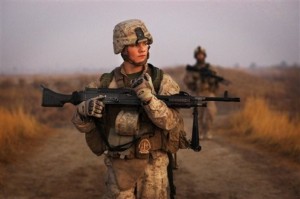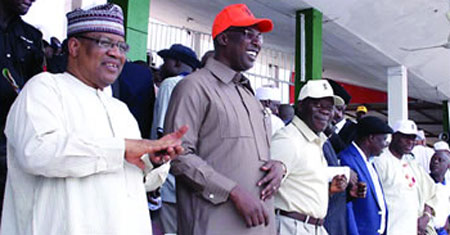 The last US combat brigade pulled out of Iraq and crossed into Kuwait almost seven and a half years after the US-led invasion to oust Saddam Hussein, US media reported.
The last US combat brigade pulled out of Iraq and crossed into Kuwait almost seven and a half years after the US-led invasion to oust Saddam Hussein, US media reported.
Television footage showed an NBC reporter travelling with the 4th Stryker Brigade, 2nd Infantry Division crossing the border into Kuwait to be followed in the coming hours by the rest of the brigade.
The pullout comes just one day after a suicide bomber blew himself up at a crowded army recruitment centre in Baghdad killing 59 people, as violence coinciding with the Muslim holy month of Ramadan raged across Iraq.
The attack, blamed on Al-Qaeda and the deadliest this year, wounded at least another 100 people and came a day after Iraq’s two main political parties suspended talks over the formation of a new government.
News of the milestone withdrawal was also carried by Al-Jazeera and US media such as The Washington Post, CNN and The Los Angeles Times, many of which had reporters embedded with the departing troops.
CNN reported that 56,000 troops will remain in Iraq after the brigade has left.
Only 50,000 are set to stay past August 31, when the United States declares an end to combat operations and switches to a training and advisory mission.
US State Department spokesman Philip Crowley, live on MSNBC as the footage was shown, described the end of combat operations as a “historic moment,” but vowed that America’s long-term commitment was unwavering.
“The last thing that we want to see is an occasion where we have to send troops back into Iraq yet again so we are ending the combat phase of our involvement in Iraq for a second time,” he said.
“We’re not ending our involvement in Iraq. We will have important work to do. This is a transition. This is not the end of something. It’s a transition to something different. We have a long-term commitment to Iraq.”
Crowley said that after spending one trillion dollars in Iraq and with 4,400 lives lost, the conflict had come “at high expense.”
“We’ve invested heavily in Iraq and have to do everything we can to preserve that investment to integrate Iraq along with the neighborhood into a much more peaceful situation that serves their interests as well as ours.
“But this is a historic moment.”
In a letter dated August 18 and posted on the White House website, President Barack Obama also hailed the end of combat operations but made no mention of the final combat troops leaving on Wednesday.
“Shortly after taking office, I put forward a plan to end the war in Iraq responsibly,” the president said in the letter.
“Today, I’m pleased to report that — thanks to the extraordinary service of our troops and civilians in Iraq — our combat mission will end this month, and we will complete a substantial drawdown of our troops.”
The Los Angeles Times report differed from other media, saying it would take three days for the 360 military vehicles and 1,800 soldiers of the 4th Brigade to get down the road from Baghdad, through the Shiite south and into Kuwait.
Other media talked of the pullout being complete in a matter of hours.
The Pentagon had long said that the 64,000 American soldiers in Iraq would fall to 50,000 by the end of the month, despite warnings from senior Iraqi politicians and officers about the dangers of an early exit.
All US troops are supposed to leave the country by the end of next year, according to the terms of a bilateral security pact, and Obama has insisted the ongoing withdrawal is on schedule and will not be altered.
Iraq’s top military officer told AFP last week on the sidelines of a defense ministry conference in Baghdad that American forces may be needed in the conflict-wracked nation for a further decade.
“At this point, the withdrawal is going well, because they are still here,” Lieutenant General Babaker Zerbari said.
“But the problem will start after 2011 — the politicians must find other ways to fill the void after 2011. If I were asked about the withdrawal, I would say to politicians: the US army must stay until the Iraqi army is fully ready in 2020.”
Associated Free Press (AFP)











